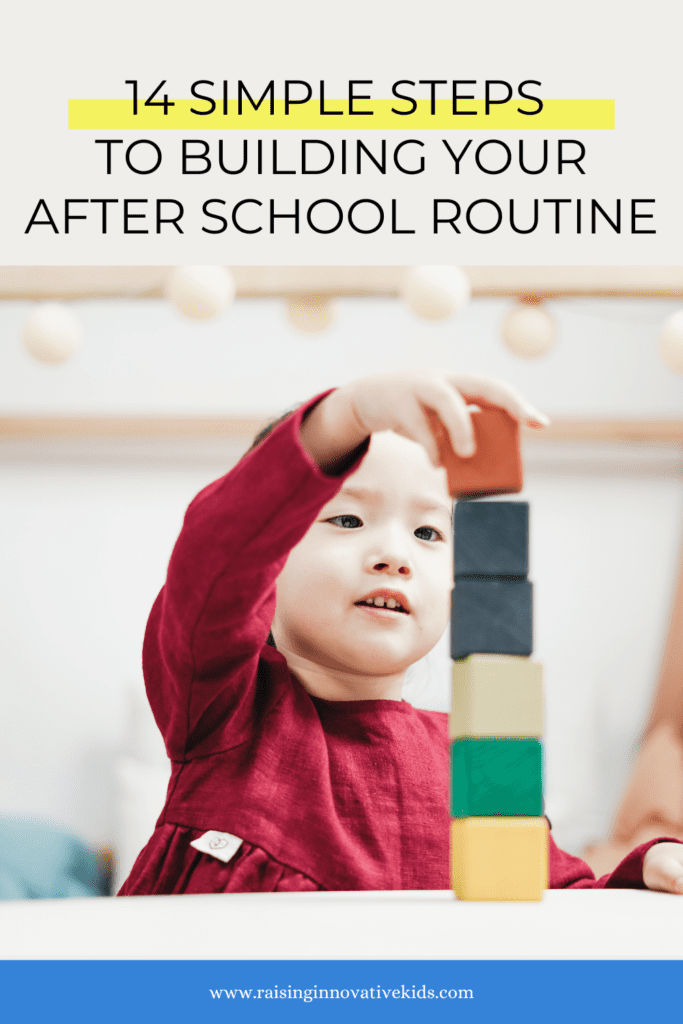14 Simple Steps to Building Your After-School Routine
Think about how most of your day goes. You rush in the morning to get ready for the day, you rush to get kids to school on time. You rush to your next appointment. You rush through lunch forgetting to even taste your food. You rush to pick up the kids, get laundry going, get dinner going, and get chores and homework done. Shower or bath for kids and get them off to bed. Oh, don’t forget to brush your teeth and read for 20 minutes.
Why do we insist on our lives being rushed through, busy, and unenjoyable? This after-school routine is meant for parents who want their kids to grow up to be successful AND happy.

After School Routine Starts Before Pick up
Before you pick up your kid, take a few breaths into the present moment. Let the chores, appointments, and lingering to-do list slip off your mind so you can be present when you pick up your child. Tune in to see how you are feeling and intentionally try to create a feeling of calm within yourself BEFORE you pick up your child.
During Pickup
1. Tune out the hectic pickup line
Double parked cars, horns blaring, and children rushing. Nothing sounds more hectic. Try to tune it out and breathe in the calm. When your child greets you, you want to be present so you can tune in to what they need.
2. Smile and Greet your child
Sometimes I need to be reminded that this little human has feelings, needs, and desires just as real as mine. How would I want to be greeted by someone after a long day at school?
3. Tune in to your child
Ask your child open-ended questions. Don’t worry about giving advice or directing them. Our kids are smart and they can figure out solutions for themselves. Be a listening ear. Provide input where you feel it is needed, but try doing it with a question as questions encourage critical thinking.
4. On the drive (or walk) home
If you’re fortunate to be able to walk, then take the time to enjoy being outside together. Walk slow, talk and listen to each other, and do your best to keep your phone (and its notifications) out of your business.
If you’re driving, listen to music you both enjoy, and keep distractions to a minimum as you ask your child questions. Don’t be afraid to tell them about your day too.

5. Hug your kid & voice expectations
Remember that physical contact with your child is a connection point. Hug your kid when you get out of the car, before going in the house, and if you’re walking, during the walk. During the drive/walk, talk to your child about what is going to happen when you get home.
When you Get Home
Now that you’re home, the real routine kicks into gear. After a couple of days, your child will know what to do and what to expect and this will become second nature.
6. Get a snack
Nutritious food and a drink will be the perfect way to connect and finish any conversations started in the car. Your kid will likely be very tired from a long school day.
7. Go through Backpacks
Check if there is anything your teacher sent home with your child. Ask them about their art and homework.
8. Have Free Time for 20 – 30 minutes
After having a snack is the best time for your child to unwind from the day and engage in free time. Free time can look different for each child. Maybe they are reading or playing with legos. Encourage your kids to do something on their own.
9. Give Choices to help your child decide what to do
I give my child two to three choices and let them know they have X amount of time (I usually push for 45 minutes). If they don’t want to do any of them, then we jump into chores. I’ll make chores up if I need to.
Ideas for after-school activities that they can do independently:
- Play outside
- Legos/Building Activities
- Arts/Drawing
- Reading
- Nap
- Kitchen Experiments*
*My child wanted to make Fanta so he pulled out sprite and food coloring. He promised not to make a mess and he actually kept that promise. Sometimes I’ll let him “do dishes” where he plays with the bubbles and water in the sink. Other times, he will experiment with baking soda, vinegar, and dish soap. There are lots of hands-off activities that can be done in the kitchen but to get started it does take some coaching.
10. Limit Screen Time to Once or twice a week
If you still have a lingering to-do list, engaging in limited, parent-approved screen time for 30 to 45 minutes once or twice a week is a great way for you to have some uninterrupted time and for your child to sit and relax.
Please remember that while screen time is an indulgence for our child, it isn’t an activity that truly re-energizes our child. In fact, if you’ve ever binge-watched TV or scrolled Instagram for hours at a time, you know that it leaves you feeling depleted rather than energized.
11. Engage in after-school activities one to three times a week (if you want)
I prefer to limit my child to one activity at a time, but this fall we are going to try Gymnastics and Soccer this fall at the same time. Neither one of them are truly competitive and we hope it will increase confidence in our young son.
I like him being in a physical sport because I think it teaches him how to move his body and after sitting all day, it can only be good for him. Music also lights up creative portions of the brain and encourages innovation and critical thinking so I will likely put him in beginning piano or singing at the end of Soccer.

12. Do a Chore together
You may want to work together for 10 minutes to get a chore done.
Ideas of chores for elementary-age kids:
- Pick up bedrooms
- Start laundry
- Wipe down counters
- Clean baseboards
- Pick up toys
- Organize anything*
*My son loves to “organize” and it’s a great activity that really engages them and helps them take ownership over their things.
Other Things To Keep In Mind
Here are a few things to keep in mind as you go throughout your afternoon.
13. Having a Calm Afternoon Leads to a Calm Evening
Remember you do not have to rush rush rush through life. Slow down and take time to enjoy it.
14. Play with your kids
You do not have to play with your kids the entire afternoon. It’s really good for them to be independent with little to no coaching from you. If you want to play with them the entire time, that is great! But remember to give them space to do their own thing too.
Bonus Tips
15. Connect with your kids
Spending 15 minutes of quality time with your child per day deepens your connection with them and makes them feel close
16. How to handle meltdowns
Meltdowns often come from being overtired or feeling disconnected. Hug your child several times during the afternoon – physical touch helps them feel connected. If they are struggling to regulate their emotions, take the time to hold them or ask them to lay down for 10 minutes to reset and re-energize their minds and bodies.

Conclusion
As your child grows and gets more independent they need you less and less, and they obey less and less. They do what they want and we hope we’ve instilled good values in them that they make good decisions. Our influence with them only goes as far as the strength of our relationship with them. This after-school routine helps you connect with your child and grow your relationship into a strong healthy parent-child relationship that will last throughout the years.







One Comment